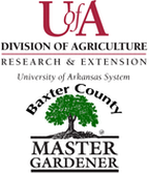|
Ozark Green Thumb BCMG Monthly e-Newsletter |
|
|
|
By Brad Runsick, University of Arkansas County Extension Office, Agent
All across Arkansas this past season, commercial growers and home gardeners participated in a tomato variety trial. Here in Baxter County, our growers James and Diana Wiegand of Bright House Farms, participated in the project. Both are members of the Baxter County Master Gardeners. The goal of the project was to take three relatively well-known tomato varieties and monitor them through the year for disease incidence as well as their overall yield of marketable fruit and total weight yield. Growers had the option to manage their disease and insect pressure either with conventional or organic pesticides. For the Baxter County project, Bright House Farms opted for the latter. Growers were given 6 plants of each of the following varieties: ‘Cherokee Purple’ (an heirloom variety) ‘Sungold’ (a small, golden cherry tomato) ‘Celebrity’ (a standard size, slicing tomato) Prior to the planting, soil sampling was done to determine if there were any major nutrient needs or soil pH adjustment needed via lime or sulfur. Per label directions, Dipel WP (wettable powder) was used to manage insects and copper fungicide and Serenade RTU were used for disease management. Plants went in the ground on 4/21 and the project was terminated on 8/28 due to slowed production and plant vigor. The project ran into a few pest problems throughout its time. The ‘Cherokee Purples’ really struggled, contracting cucumber mosaic virus (CMV), which is vectored by aphids. The abundance of rain early in the season caused many fruit to split, making them unmarketable, and prone to further disease occurrence. Toward the end of the season, around August, the stinkbug damage became so prevalent that puncture wounds from the feeding resulted in many more fruit that were unmarketable. Here’s a brief summary of the yields that were logged:
As expected, the heirloom struggled when compared to the two hybrids in regards to overall plant vigor and disease occurrence. The nature of the of the Purples to grow large, bumpy tomatoes does lend itself to producing some fruit that generally aren’t marketable due to their appearance and fruit splitting. Bear in mind, many of the unmarketable fruit are fine to eat from a home garden. Defining fruit as marketable or unmarketable is looking at it from a commercially grown, “this tomato has to sell on the shelf” point of view. The two hybrids have some built in resistance to disease, particularly the soil borne Verticillium and Fusarium wilts. So some of their production may be attributed to that resistance. Regardless of all of this, just grow whatever tomato you like the taste of best! Some are easier to care for than others are, but they’ll all produce something to put on your plate. For information on tomato production in the home garden, give us a call sometime at 870-425-2335 or stop by our office at 3 E. 9th St. in Mountain Home. Much thanks to James and Diana Wiegand and Bright House Farms for their participation in this project. Their farm is located near Midway, and they sell at the local farmers’ markets. They did all the work. I just got the plants and wrote this summary!
1 Comment
Jonathan Smith
11/6/2019 03:41:28 pm
I grew Cherokee purple, pink brandywine, brads atomic cherry and yellow brandywine tomatoes with similar results. All had mosaic virus and then the parent or stink bugs had their fill of my tomatoes. There's always next year...
Reply
Leave a Reply. |
Archives
April 2022
|
|
